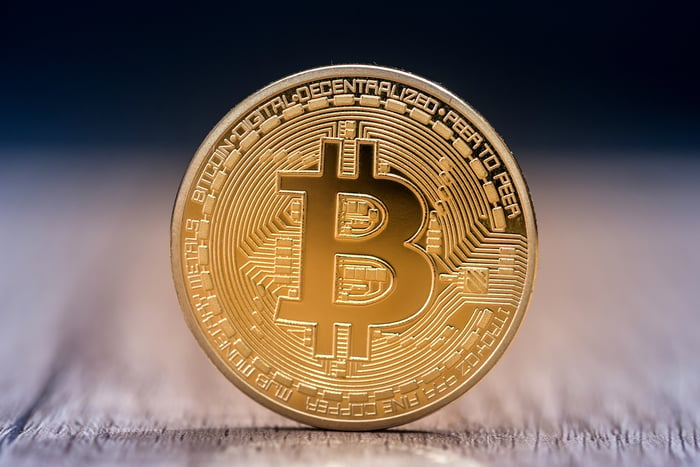Traditionally, the stock market is the go-to investment for people who understand the value that time and compounding can bring to the table. Over its long history, the stock market has returned an average of 7% annually, inclusive of dividend reinvestment. This works out to a rough doubling of your invested nest egg once a decade.
The world's top investment this decade
Recently, though, all eyes have been on the incredible returns of cryptocurrencies like bitcoin. This year, bitcoin is approaching a nearly 600% gain, and it's up well over 2,000% since its low point in 2015. By comparison, the broad-based S&P 500 has taken decades to return what bitcoin has in just two years. In fact, bitcoin's market cap recently touched $110 billion, which is larger than quite a few established Dow Jones Industrial Average components.

Image source: Getty Images.
Admittedly, few, if any, people could have envisioned what bitcoin would become back in 2009 when it debuted or in March 2010 when it was first listed on the now-defunct BitcoinMarket.com exchange. However, if you were lucky enough to grab hold of any amount of bitcoin back in March 2010, when it hit a low of $0.003 (that's three-tenths of one cent), you'd be sitting on a veritable gold mine right about now. A $1,000 investment in bitcoin back in March 2010 would have purchased approximately 333,333 bitcoin (assuming no fees), which as of Nov. 1, 2017, would have yielded a value of $2.2 billion. That's right, folks: $1,000 to $2.2 billion in just seven years and eight months. That's just your run-of-the-mill compound annual return of 571%.
Explaining bitcoin's meteoric rise
What lit a fire under bitcoin and allowed it the opportunity to grow so quickly? It pretty much boils down to three factors.
The most logical explanation is the potential for blockchain, which is the digital and decentralized ledger that underlies most virtual currencies. Blockchain is what logs all transactions without the need for a financial intermediary like a bank, and it's usually open source, which makes altering logged data almost impossible. This added security is what makes this new technology such an attractive option for the financial services industry. Though still in its infancy, pundits suggest that blockchain could be worth billions.
Second, bitcoin has been moved by news-driven events. Examples include a handful of brand-name companies announcing that they'd begin accepting bitcoin as a form of payment in 2014, as well as Japan revealing earlier this year that it would begin accepting bitcoin as a form of legal tender.

Image source: Getty Images.
Perhaps the biggest recent news comes from futures trading giant CME Group (CME -1.93%), which announced this past week that it plans to launch futures trading for bitcoin. Doing so should help reduce some of the wild volatility tied to bitcoin by allowing institutional investors an easier way to invest in the virtual currency. At the same time, it gives CME Group a brand-new channel of trading revenue considering the popularity of bitcoin.
Third, emotions and scarcity have played a role. As noted, listing on the CME futures trading platform will broaden the scope of trading for institutional investors, but it hasn't always been this way. In fact, bitcoin has predominantly been priced by retail investors since institutional investors were barred from trading in bitcoin. Retail investors are far more likely to allow their emotions to get the better of them than institutional investors, which has led to very strong rallies, and declines, throughout bitcoin's eight-year history.
Three major concerns about bitcoin's parabolic move
However, bitcoin's meteoric rise may ultimately not last long. One concern is that regulation acts as a double-edged sword for bitcoin, and virtual currencies as a whole. Increased regulation in the space would help to validate that these virtual currencies have some sort of value. Conversely, regulations can also close doors for cryptocurrencies. An example would be China and South Korea both outlawing initial coin offerings, as well as China announcing that it would be shutting down all of its domestic cryptocurrency exchanges.

Image source: Getty Images.
A second issue is that while few people would dispute what blockchain could bring to the table, no one has any idea what its true value is. Investors have a storied history of overestimating the adoption of new technology. It's happened time and again throughout history, and there's nothing to say that blockchain isn't the next hot thing on the list. For the time being, blockchain technology is only being tested in small-scale and pilot projects, suggesting it could be some time before it has any chance of broader adoption.
Building on this point, there's absolutely nothing to suggest that bitcoin's blockchain will be the one big businesses choose. Although bitcoin recently upgraded its blockchain in order to boost capacity, speed up settlement times, and lower transaction fees, it's competitor Ethereum that's drawn far more interest from enterprises given its smart contract protocols built into its blockchain. With such a low barrier to entry in developing blockchain, bitcoin could find itself exceptionally vulnerable on its current perch.
But the biggest concern of all might be that investors are misconstruing what's really important. Bitcoin's blockchain is where its value lies, not the virtual currency. Yet, many are enamored with the potential for the currency itself. Buying into bitcoin gives you no stake in a company. Instead, you own virtual currency that you'd likely struggle to live off if you needed to buy basic goods and services.
Now more than ever, I'll reiterate my view that bitcoin looks like a bubble waiting to pop.


